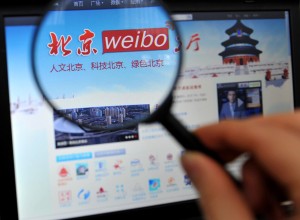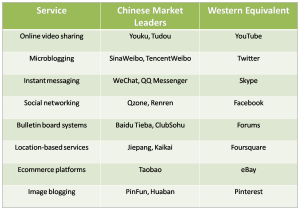 When entering the Chinese market, one of the key challenges for any foreign company — especially small and medium-sized enterprises (SMEs) — is effective marketing. Whereas traditional media such as newspapers, magazines, radio and television are hardly an option — mainly due to the costs involved — ease of access, low costs and high relevance make the booming social media landscape in China the prime playing field for European SMEs looking to increase visibility of their brands and products here.
When entering the Chinese market, one of the key challenges for any foreign company — especially small and medium-sized enterprises (SMEs) — is effective marketing. Whereas traditional media such as newspapers, magazines, radio and television are hardly an option — mainly due to the costs involved — ease of access, low costs and high relevance make the booming social media landscape in China the prime playing field for European SMEs looking to increase visibility of their brands and products here.
Jonas Rasch of the EU SME Centre says that in a recent webinar they conducted 83 per cent of participating SMEs stated that marketing is the principal reason for their online engagement in China. In the following article he gives some pointers as to how this can be done successfully.
Guanxi 2.0
With news of censors in China blocking Google, Twitter or Facebook repeatedly broadcast on Western media, Europeans might be misled to believe that the social media wave that swept the world in the last few years has not been able to breach China’s Great Firewall. While it is generally true that foreign market leaders in social networking, Ecommerce and mobile internet have not been allowed to operate freely within the country, this has in no way hindered the rapid development of social media in China.
Precisely because dominant Western companies have been kept at bay, a large number of local competitors and start-ups have had the opportunity to first copy and later innovatively adjust and expand their services, turning China into the largest internet market in the world today.
By December 2012, there were 564 million internet users in China, almost 200 million more than in the European Union. This number translates into a penetration rate of 42.1 per cent of the population, leaving ample room for growth in the coming years. More than 90 per cent of all users are active in social media, a higher percentage than anywhere else in the world.
A number of reasons have been given for the rapid spread of internet usage in China, amongst them increasing purchasing power, affordable broadband internet connections and the wide use of smart phones (today, more people access the internet via smart phones than desktop computers in China), whereas cultural factors might explain the popularity of social media in particular.
Personal connections, or guanxi, have always been highly valued in Chinese society and social media offers all the tools necessary to maintain these relationships independent of time or location. A general mistrust towards official media channels is said to motivate the Chinese to look for independent information online, while a lack of personal relations amongst young Chinese might explain the intensity and openness with which they publish their views to a potentially limitless audience.
In addition, China’s younger generations are known to be early adopters of innovative technology: the instant messaging application Weixin (or WeChat in English), for example, was launched in January 2011, went global in August 2012 and now boasts more than 300 million users.
No matter what the underlying reasons are, Chinese consumers spend a remarkable amount of time online and use a huge amount of that time for interacting with others via social media. When factoring in that 44 per cent of respondents in a recent Nielsen study stated that they use social media to learn about products, and with many users in China experiencing the internet almost exclusively via social media, the potential of attractive, localised marketing activities on China’s social media becomes apparent.
The right platform for the right audience
Social media encompasses a number of different modes of online communication, presented in different ways to different audiences. Whereas the number of popular service providers is fairly small in the West, each Western platform has many equivalents and spin-offs in China, making the market vast and difficult to assess at any given moment. Platforms popular a year ago might be struggling today, while newcomers can attract millions of users within a few months. The market can be divided into the following main services:

Breakdown of internet services with Chinese leaders and Western equivalents.
Please click for larger image.
While social networking sites (SNS) like Facebook are dominating social media in the West, microblogging platforms (the equivalent to Twitter) have overtaken SNS in China, reaching 97 per cent of all mainstream social media users—even though it has to be noted that microblogging sites in China offer many more options to users than Twitter, thus blurring the line between the two services.
SinaWeibo is by far the most popular microblogging platform, with an estimated 320 million registered users. It has been allowing users to post videos and photos for years, while companies can set up their own branded pages, including streaming videos, launch micro activities like competitions and polls, and publish so-called Wei Magazines that group high-quality content into a magazine-like format without the usual 140 character limitation.
While SNS tend to be used to communicate with friends, microblogs constitute a more public environment and are thus better suited for marketing purposes. That being said, a sustained marketing effort should not ignore other social media arenas as Chinese users are active on multiple platforms and popularity of a single platform can shift rapidly.
European SMEs also need to be aware that China’s social media sector is very fragmented and local, with different players catering to different audiences in terms of age, interests, education, income levels and geographic location. While QZone—the first and largest social networking site in China—attracts mostly youth to the age of 25, often from second- and third-tier cities, Douban is frequented by students and academics passionate about arts and culture living predominantly in first-tier cities.
It is advisable to work with local staff familiar with the different platforms and services available and versed in local preferences in style and presentation to increase the likelihood of reaching a higher percentage of your target group.
 Taking it seriously
Taking it seriously
Social media marketing is not advertising. The term ‘media’ is misleading in that it is still associated with traditional media, which generally constitutes a one-way street from sender to receiver. Social media is all about two-way conversations, with the responses deserving just as much, if not more, attention as the original message. It is imperative to think of social media marketing in terms of ongoing conversations with your past, current and potential customers.
Social media is a unique tool in that it is useful at every stage of the consumer pathway: it creates awareness through your own posts and advertising; it enables potential customers to interact with your company, leading to engagement and active consideration of your products; after the purchase has been made, social media is ideally positioned to facilitate after-sales services and relationship building.
However, the ultimate goal of all marketing efforts in social media goes beyond establishing and maintaining relationships—it is a tool to turn customers into advocates for your company by motivating them to inform their peers of your offerings through their own links, re-posts and publicly accessible responses.
Naturally, negative posts spread just as quickly as positive ones and Chinese companies have been known to go so far as to intentionally spread fabricated complaints about products to harm their rival’s reputation. Even if it is unlikely that small European companies will be confronted with this kind of malicious intent, it is important to follow the trail of your followers.
Many Chinese customers rely exclusively on the internet to gather information before making a purchasing decision. Newly acquired products are closely scrutinised and many post detailed accounts of their experiences online to help others in their decision-making process. The only way to influence these discussions and respond to grievances quickly is to be present on these same platforms and be as active on them as your customers.
Setting up accounts is free on almost all platforms available in China, but their maintenance needs to be a top priority, which means allocating knowledgeable and responsive staff to the task. Ideally, the conversation needs to be kept going (or at least monitored) around the clock, so as not to miss any development that might seriously influence your business.
All of this goes to show that while social media marketing in China is a great way to connect with your target group and (influence them to) spread the word on your products, it is only effective if done with commitment, knowledge and appropriate funding. Even though it is difficult to determine the return on investment in social media marketing, as analytic tools are even scarcer in China than they are in the West, it is by far the most cost-effective and versatile way to raise visibility amongst Chinese consumers to date.
For more information, including the report Selling Online in China and a recording of the recent webinar How to Develop a Robust Digital Marketing Strategy in China, please visit www.eusmecentre.org.cn. A report specifically on marketing in China is planned for publication later this year. To keep up-to-date about the Centre’s events and publications, find us on Twitter, Facebook and LinkedIn.
 The EU SME Centre assists European SMEs to export to China by providing a comprehensive range of free, hands-on support services including the provision of information, confidential advice, networking events and training. The Centre also acts as a platform facilitating coordination amongst Member State and European public and private sector service providers to SMEs. The EU SME Centre is a project funded by the European Union.
The EU SME Centre assists European SMEs to export to China by providing a comprehensive range of free, hands-on support services including the provision of information, confidential advice, networking events and training. The Centre also acts as a platform facilitating coordination amongst Member State and European public and private sector service providers to SMEs. The EU SME Centre is a project funded by the European Union.


Hello There. I found your blog the use of
msn. That is a really smartly written article. I’ll make sure
to bookmark it and come back to learn more of your helpful info.
Thank you for the post. I will definitely comeback.
Thanks for finally talking about >Of Micro Blogs and Macro
Markets – EURObizEURObiz <Liked it!